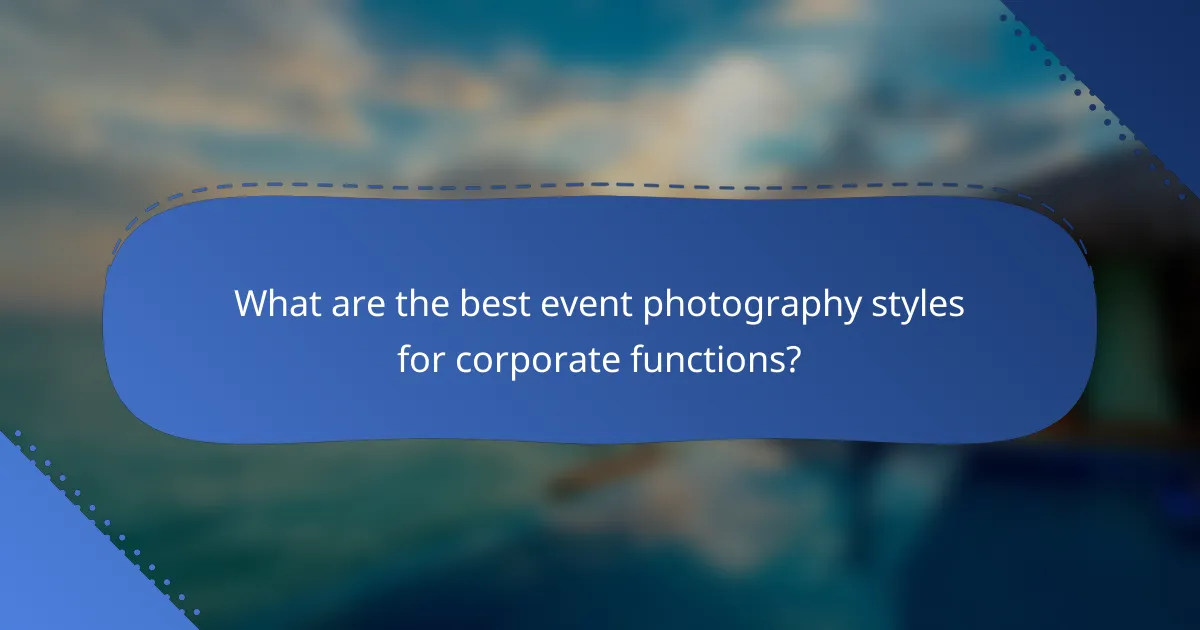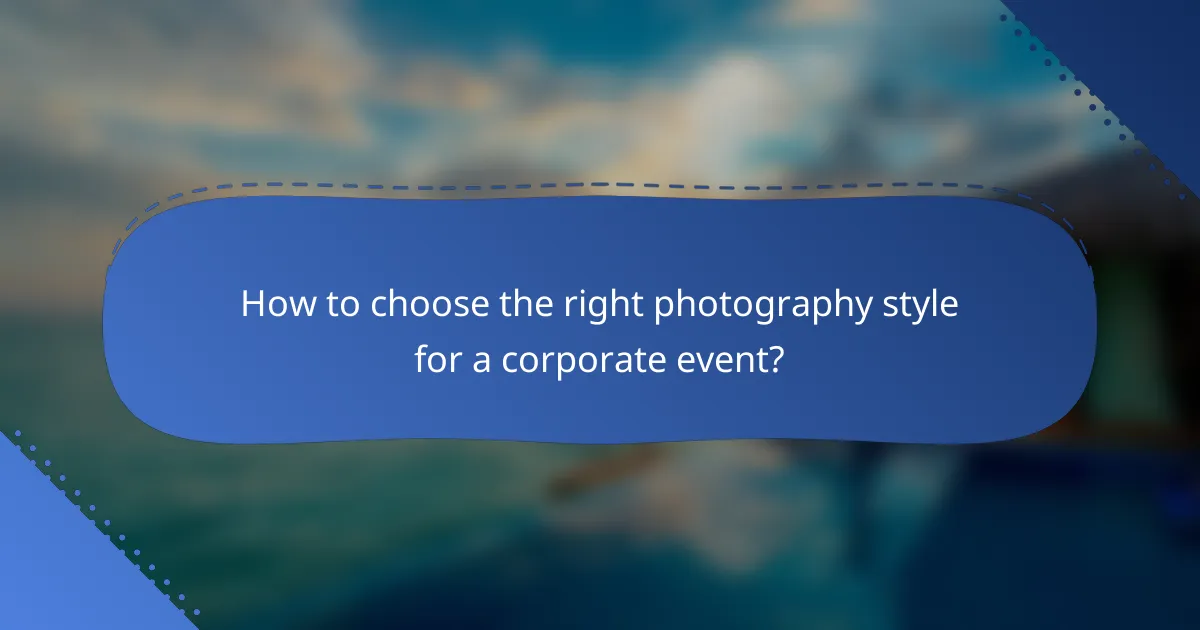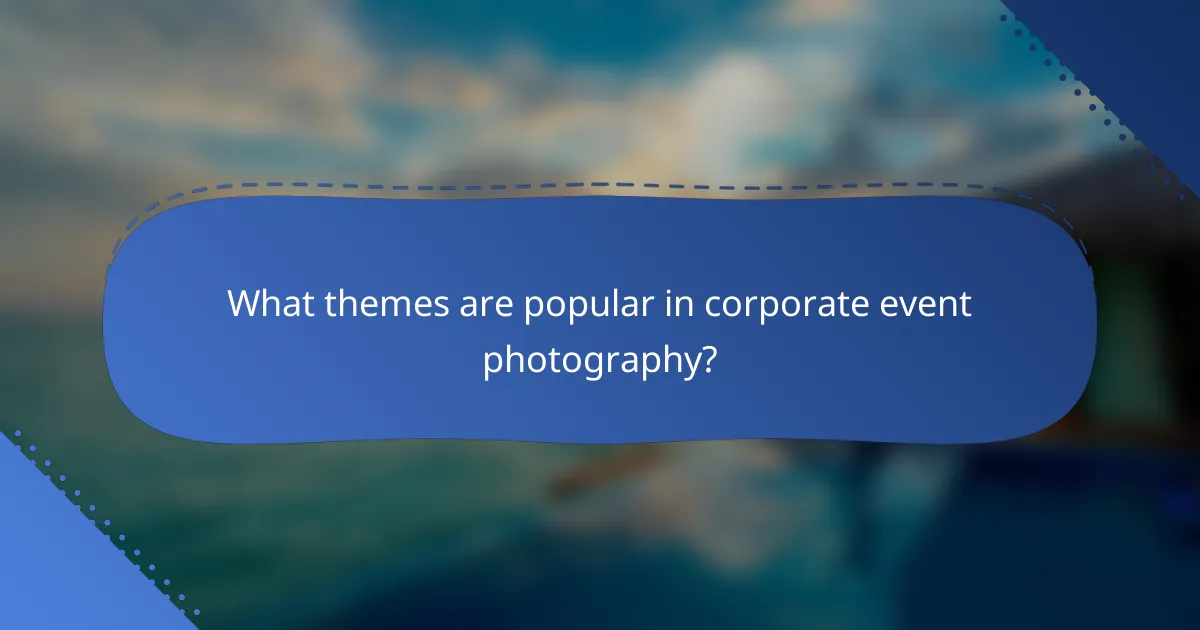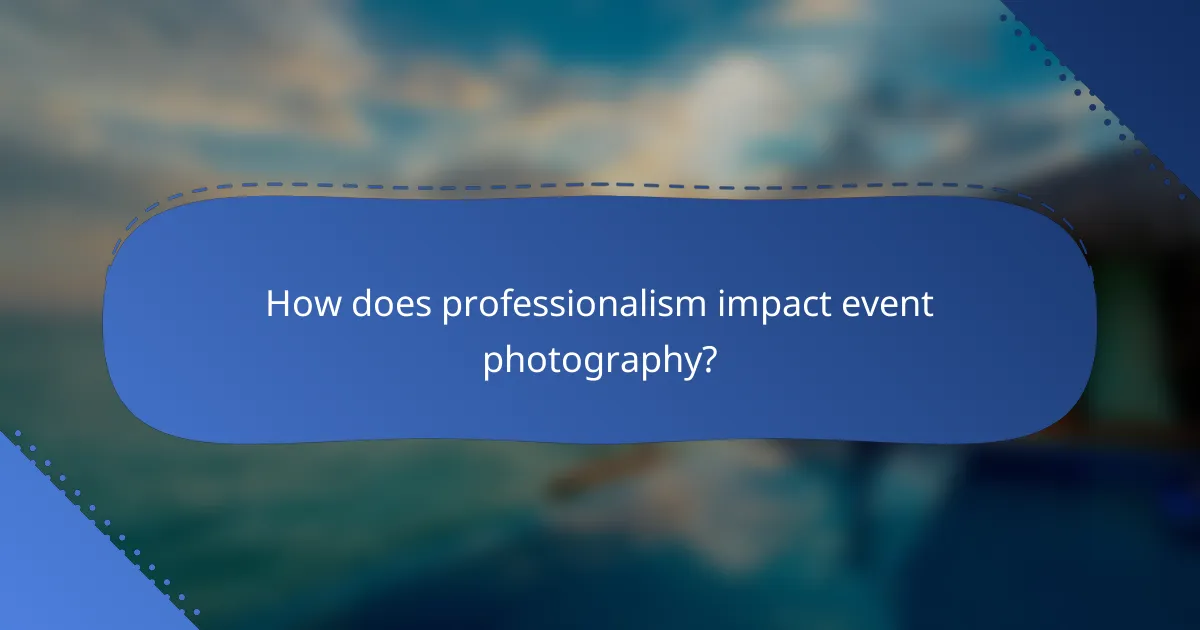Event photography plays a crucial role in capturing the essence of corporate functions, with styles such as traditional, candid, and documentary photography tailored to enhance professionalism and branding. Choosing the right style involves considering the event’s goals and audience, ensuring that the photography effectively communicates the intended message. Themes like networking events, product launches, and conferences further influence the approach, allowing photographers to showcase the brand’s identity and create a memorable experience.

What are the best event photography styles for corporate functions?
The best event photography styles for corporate functions include traditional, candid, documentary, editorial, and creative portrait photography. Each style serves a unique purpose and can enhance the overall presentation of the event, catering to different aspects of professionalism and branding.
Traditional corporate photography
Traditional corporate photography focuses on posed shots that capture key moments and attendees in a formal manner. This style often includes group photos, headshots, and images of speakers at podiums, which are essential for corporate branding and documentation.
When using traditional photography, ensure that the background is professional, and the lighting is flattering. It’s important to communicate with subjects to help them feel comfortable and natural during the shoot.
Candid event photography
Candid event photography captures spontaneous moments and genuine interactions among attendees. This style is effective in showcasing the atmosphere and emotions of the event, providing a more relaxed and authentic representation.
To achieve great candid shots, photographers should blend into the crowd and remain unobtrusive. Look for moments of laughter, conversation, and engagement to convey the event’s energy and spirit.
Documentary-style photography
Documentary-style photography tells a story through a series of images, capturing the event’s progression from start to finish. This approach is ideal for corporate functions that involve multiple activities, such as conferences or workshops.
Photographers should focus on key moments, interactions, and details that reflect the event’s theme and objectives. This style often results in a comprehensive visual narrative that can be used for reports or promotional materials.
Editorial event photography
Editorial event photography combines elements of journalism and artistic composition, often used for publications or marketing materials. This style emphasizes storytelling through images, focusing on the event’s highlights and key messages.
When planning for editorial photography, consider the target audience and the intended use of the images. Photographers should aim for a mix of wide shots and close-ups to create a dynamic visual experience.
Creative portrait photography
Creative portrait photography involves artistic and imaginative approaches to capturing individuals or groups at corporate events. This style can include unique angles, lighting techniques, and props to enhance the visual appeal of the portraits.
To create standout portraits, collaborate with subjects to understand their preferences and the event’s branding. Experiment with different settings and compositions to produce striking images that reflect the corporate identity.

How to choose the right photography style for a corporate event?
Selecting the appropriate photography style for a corporate event involves understanding the event’s goals, audience, and venue. A well-chosen style enhances the overall experience and effectively communicates the intended message.
Assessing the event’s purpose
The purpose of the corporate event significantly influences the photography style. For instance, a formal gala may require a classic, elegant approach, while a product launch might benefit from a more dynamic, contemporary style. Consider whether the event aims to celebrate, inform, or network, as each goal suggests different visual storytelling techniques.
Identify key moments that need capturing, such as speeches, awards, or networking sessions. This will help in determining whether candid shots or posed portraits are more appropriate, ensuring that the photography aligns with the event’s objectives.
Understanding the audience
Knowing the audience is crucial for selecting a fitting photography style. Different demographics may respond better to certain aesthetics; for example, a younger audience might appreciate a vibrant and informal style, while a more traditional crowd may prefer classic, polished images.
Consider the industry and the attendees’ expectations. For corporate events, maintaining professionalism is key, but incorporating elements that resonate with the audience can enhance engagement. Tailoring the photography to the audience’s preferences can lead to more impactful images.
Considering the venue
The venue plays a vital role in determining the photography style. A spacious, modern conference center may lend itself to wide-angle shots and a more contemporary feel, while a historic building might require a classic approach to highlight its architectural beauty.
Evaluate the lighting conditions and available backdrops at the venue. Natural light can enhance candid photography, while controlled lighting may be necessary for formal portraits. Understanding the venue’s layout can help in planning effective compositions and ensuring that the photography captures the essence of the event.

What themes are popular in corporate event photography?
Corporate event photography often revolves around themes that enhance the professional atmosphere and showcase the brand’s identity. Popular themes include networking events, product launches, conferences and seminars, and team-building activities, each requiring specific approaches to capture the essence of the occasion.
Networking events
Networking events focus on building professional relationships and often feature a mix of formal and informal interactions. Photographers should capture candid moments, group discussions, and key speakers to highlight the event’s dynamic atmosphere. It’s essential to ensure that attendees feel comfortable, as natural expressions lead to more engaging images.
Consider using a mix of wide shots to show the venue and close-ups of interactions. This variety helps convey the event’s energy and purpose. Always seek permission before photographing individuals, especially in less formal settings.
Product launches
Product launches are pivotal moments for companies, showcasing new offerings to clients and stakeholders. The photography should emphasize the product itself, along with the excitement and engagement of the audience. Capturing the unveiling moment, reactions from attendees, and promotional materials is crucial.
Utilize lighting techniques to highlight the product effectively, and consider incorporating branding elements in the background. A well-planned shot list can help ensure that all critical moments are captured, from the initial reveal to audience interactions.
Conferences and seminars
Conferences and seminars typically involve presentations, panel discussions, and networking opportunities. Photographers should focus on capturing speakers in action, audience engagement, and the overall atmosphere of learning and collaboration. It’s important to document key moments, such as Q&A sessions and breakout discussions.
Using a mix of candid and posed shots can provide a comprehensive view of the event. Consider the venue’s layout to identify the best angles for capturing speakers and attendees. Always be mindful of the event schedule to ensure you are present during critical moments.
Team-building activities
Team-building activities are designed to foster collaboration and camaraderie among employees. Photography should reflect the fun, engagement, and teamwork involved in these exercises. Candid shots of participants working together, laughing, and enjoying the activities are vital for conveying the event’s spirit.
Incorporate a variety of shots, including group activities and individual interactions, to showcase the diversity of experiences. It’s beneficial to communicate with event organizers beforehand to understand the planned activities and key moments to capture.

How does professionalism impact event photography?
Professionalism is crucial in event photography as it influences the quality of images captured and the overall experience for clients and attendees. A professional photographer not only brings technical skills but also a strong work ethic, reliability, and the ability to adapt to various environments and themes.
Importance of experience
Experience in event photography allows professionals to anticipate moments and capture them effectively. Photographers with a solid background understand how to navigate different settings, from corporate functions to themed events, ensuring they don’t miss key interactions or highlights.
Moreover, seasoned photographers can handle unexpected challenges, such as poor lighting or uncooperative weather, with ease. Their familiarity with various venues and event types also enables them to suggest creative angles and compositions that enhance the final product.
Quality of equipment
The quality of equipment directly impacts the professionalism of event photography. High-end cameras and lenses can capture sharper images and perform better in low-light conditions, which is often the case at corporate events or themed parties.
Additionally, professional photographers typically use advanced editing software and tools to enhance their images post-event. Investing in quality gear not only improves the final output but also reflects a photographer’s commitment to their craft.
Client communication
Effective communication with clients is essential for professional event photography. Understanding the client’s vision, preferences, and specific requirements ensures that the photographer captures the essence of the event accurately.
Regular updates and discussions before, during, and after the event help build trust and clarify expectations. This proactive approach can lead to a more satisfying experience for both the photographer and the client, resulting in better outcomes.
Post-event editing standards
Post-event editing is where the professionalism of event photography truly shines. High standards in editing can transform good images into exceptional ones, enhancing colors, correcting exposure, and ensuring consistency across the photo set.
Professional photographers often follow a systematic editing process, which may include color grading, retouching, and applying specific styles that align with the client’s branding or event theme. This attention to detail in post-production is what distinguishes professional work from amateur efforts.

What are the pricing factors for corporate event photography?
Pricing for corporate event photography varies based on several key factors, including the duration of the event, the number of photographers required, and location-related travel costs. Understanding these elements can help businesses budget effectively for their photography needs.
Duration of the event
The length of the event significantly impacts the overall cost of photography services. Typically, photographers charge by the hour, with rates often ranging from $100 to $300 per hour, depending on their experience and the market. Longer events may also require additional fees for overtime or extended coverage.
For instance, a half-day corporate function might cost less than a full-day conference. It’s essential to discuss the schedule with the photographer to get a clear estimate based on the expected duration.
Number of photographers needed
The number of photographers required for an event can influence pricing considerably. Larger events, such as conventions or multi-track conferences, may necessitate multiple photographers to capture all activities effectively. This can increase costs, as each additional photographer typically adds to the overall fee.
As a guideline, one photographer may suffice for smaller gatherings, while events with over 200 attendees often benefit from having at least two photographers. Always assess the event’s scale and complexity when determining how many professionals to hire.
Location and travel costs
Travel expenses can add to the total cost of corporate event photography, especially if the venue is located outside the photographer’s usual service area. Costs may include transportation, accommodation, and meals, which can vary widely based on distance and local rates.
For example, a photographer based in a major city may charge extra for travel to a remote location. It’s advisable to clarify these potential costs upfront to avoid surprises in the final invoice.
